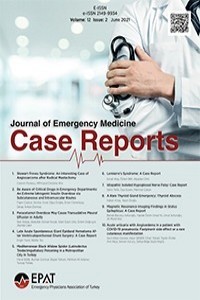Aneurysmal Subarachnoid Hemorrhage Presenting with Neurogenic Pulmonary Edema and Hemoconcentration
___
- 1. Baumann A, Audibert G, McDonnell J, Mertes PM. Neurogenic pulmonary edema. Acta Anaesthesiol Scand. 2007; 51: 447-55.
- 2. Davison DL, Terek M, Chawla LS. Neurogenic pulmonary edema. Critical Care. 2012; 12: 212.
- 3. Allen MT, Patterson SM. Hemoconcentration and stress: A review of physiological mechanisms and relevance for cardiovascular disease risk. Biol Psychol. 1995; 41: 1-27.
- 4. Di Battista AP, Rizoli SB, Lejnieks B, Min A, Shiu MY, Peng HT, et al. Sympathoadrenal Activation is Associated with Acute Traumatic Coagulopathy and Endotheliopathy in Isolated Brain Injury. Shock. 2016; 46: 96-103.
- 5. Choi KS, Kim JM, Ryu JI, Oh YH. Concurrent Ruptured Pseudoaneurysm of the Internal Carotid Artery and Cerebral Infarction as an Initial Manifestation of Polycythemia Vera. J Korean Neurosurg Soc. 2015; 58: 137-40.
- Yayın Aralığı: 4
- Başlangıç: 2010
- Yayıncı: Alpay Azap
Gülhan GÜLHAN GÜREL, Hikmet SACMACI
Esra OZCAKIR, Serpil SANCAR, Gokhan ORCAN, Mete KAYA
Kivanc KARAMAN, Cihangir CELİK, Alten OSKAY, Hamit Hakan ARMAĞAN, Onder TOMRUK
Muhammet ARSLAN, Sinan SOZUTA, Enver REYHAN
Ercan AYAZ, Ahmet AKTAN, Abdullah ALİMOĞLU, İdris OZDAS
Ozlem TALU KENDİR, Hayri Levent YILMAZ, Seyda Beğen DOĞANKOC, Sevcan BİLEN, Sinem SARI GOKAY, Mihriban Ozlem HERGUNER
Cristina BOLOGA, Catalina LİONTE, Manuela URSARU, Laurentıu SORODOC, Elena Adorata COMAN, Gabriele PUHA, Ovidiu Rusalim PETRİS
